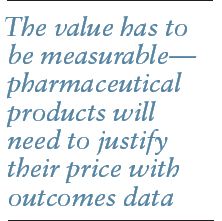Pharma Pricing: Striking a Post-ACA Balance
Making sense of the new cost-containment model and value-for-money conundrums like those in the HCV space.
Even as evidence grows that we have begun to bend the US healthcare cost curve and reduce the inexorable rise in national healthcare expenses, there is a lot of talk about pricing, particularly pharmaceutical pricing. For pharmaceutical executives, engaging in this conversation is long overdue. Healthcare pricing poses a potential threat because people may get priced out of the market. And it's not just drugs and medical devices, but pricing for medical procedures, physician visits, and hospitalization are also under scrutiny.

David Ormesher
How the ACA affects costs
The goal of the Affordable Care Act (ACA) was to slow the rise in the overall cost of healthcare and expand health insurance coverage to more Americans. Constraints on costs are expected to come from three primary market forces. First, broadening insurance coverage enlarges the risk pool and gets healthcare services to uninsured people before their illness gets too serious (and expensive).
Secondly, by moving from a fee-for-services model to a pay-for-outcomes model, the financial incentives for healthcare providers shifts to quality and coordinated care to keep people healthy and out of the hospital. Finally, as consumers begin to bear more of the direct cost of insurance and out-of-pocket co-pays, there will be additional pressure on pricing.
In our free-market economic system, we've been reticent to tell private-sector producers of products or services what they can sell a product for, leaving it to customers and competition to rationalize pricing. The ACA largely left drug pricing to the market, assuming supply, demand, transparency and outcomes data would identify the right price ranges for most products.

Pay now or pay later
However, healthcare is a special case. Unlike most consumer products and services, healthcare is rarely a discretionary purchase. We either buy health services (e.g., physician office visit, lab test, drug therapy) today when we need it-when it is the most effective to treat or cure-or we, or society-at-large, will ultimately pay for it later when the situation is likely more acute and the cost of treatment is much higher. It makes sense that we do whatever we can to offset that higher risk tomorrow by providing access to health services today.
Offsetting future financial risk requires two inputs-universal access and measurable quality. We need to cover as many people as we can to insure that everyone has adequate access to healthcare products and services-but not just any products and services. Patients need access to quality care that results in positive outcomes.
A business model transformation
In this model, insurers provide the universal patient access and providers and pharmaceutical, diagnostic, and device companies deliver the quality outcomes. However, the financial lubrication in this complex workflow will require a new approach to balancing cash flow between healthcare entities. In fact, we are in the middle of a massive restructuring of risk, payments and health accountability.
With the introduction of universal insurance coverage and new incentives for cost containment and improved health outcomes, the ACA disrupted the long-standing business model that governed cash flow and profitability among the various healthcare entities.
The ACA has forced the national conversation to shift from one about pricing to one about value. When you really unpack the philosophy behind the ACA, it is a philosophy of value: We're going to pay for outcomes, not just for procedures or services.
Is value-based pricing the answer?
Framed as value, the question then is about efficacy. Whether it's a pharmaceutical therapy, hospital stay, or a medical procedure, did it fix the problem? Did we get the kinds of long-term, healthy outcomes we're looking for? And if so, if we're able to reduce hospitalization or arrest a chronic decline in health, then the result-the value of costs saved and future productivity secured-should be factored into the acceptability of the price of achieving this outcome.
But the question remains, is there a price point that is unacceptable, regardless of the long-term value?
Do cures deserve a premium price?
Gilead's Sovaldi has become a lightning rod for this discussion. Sovaldi, which can cure hepatitis C virus (HCV) for 80% to 100% of patients who take it, carries a retail price of $84,000 for a 12-week regimen. Private payers, states insurers, and Medicare and Medicaid are up in arms at the cost. Hence, the moves by the major pharmacy benefit managers (PBMs) to cut exclusive deals with the makers of the new HCV drugs in exchange for discounts.
But on the other hand, Sovaldi is curing people, which very few drugs actually do. Compare the long-term cost of someone who has HCV, who will be on drugs and in and out of the hospital for the rest of his or her life, to a short-term spend of $84,000, and you'll recognize that while there's certainly short-term pain, there's huge long-term value.
We either pay for it now or we pay for it later. It becomes a time-value of money question.
The time-value of money
Insurance companies were built on an actuarial model of paying for chronic illness over time. There hasn't been a financial scenario that assumes there is a cure that will end treatment costs for a chronic illness, short of death. Insurers are accustomed to paying relatively smaller bills over long periods of time, not a large one-time payout.
However, if you step back from the intimidating numbers of three million HCV patients at a cost of $84,000 per patient and consider the literature that predicts treating the old way is on a path to rise from $30 billion a year to $85 billion a year over the next 20 years (complications, liver transplants costing more than $550,000 each), and that the number of new cases of HCV is falling (now only 20,000 new patients annually), not even taking into account the quality of life and productivity of those cured citizens, there is an actuarial risk/financial model that makes sense, even at a high short-term cost.
Total cost of ownership
As healthcare leaders, we need to reframe this argument in terms of total cost of ownership. There is a total cost of health in this country, and if by investing in innovative solutions today we can improve long-term cost and wellness tomorrow, then that is a move that makes sense.
The technology industry held a similar conversation 20 years ago when software and hardware manufacturers like Microsoft and IBM introduced the concept of total cost of ownership to chief information officers (CIOs). While the initial costs to outfit your entire company with IBM computers or a new Microsoft operating system might be high, if you looked at the total cost of ownership of that technology amortized over three to five years and analyzed the improved productivity and lower maintenance costs from the investment, it was actually quite affordable.
We need to look at healthcare in a similar fashion. We need to factor in the total cost of ownership-the total cost of the therapy and procedure and the total outcomes benefits-before we take severe measures like restricting access to certain types of care based on price or introducing price controls on pharmaceutical companies.
Amidst the feverish debate over pricing in healthcare, the industry needs to focus on the value that healthcare can provide to patients and let that calculation dictate relative costs. The value has to be measurable-pharmaceutical products will need to justify their price with outcomes data-but that's part of the enlightened conversation that will lead to a more rationale social and economic contract between healthcare suppliers, providers, patients, and payers.
David Ormesher is CEO of Closerlook, inc. He can be reached at dormesher@closerlook.com or on Twitter at @ormshr.

Trump: 'Major Tariff' on Pharmaceuticals Coming Soon
Published: April 9th 2025 | Updated: April 9th 2025“We’re going to tariff our pharmaceuticals, and once we do that, they are going to come rushing back into our country," President Donald J. Trump said during a Tuesday night dinner in Washington.